How To Increase Height After 18: 7 Simple Tips To Look Taller
Get those extra inches with proper diet, exercise, and other tips to appear taller.

Image: Shutterstock
Wondering how to increase your height? Adding inches to your height after you have crossed your late teens can be a difficult task, as this is when humans reach their final height. However, many people aspire to grow taller even after they turn 18. The results may not be very significant, but it is better than no growth at all.
In this article, we have listed some tips to increase your height naturally. So, what are you waiting for? Scroll down to learn more!
In This Article
Increasing Your Height After 18 – Is It Possible?
Many people say you can increase a kid’s height during childhood, but not once you are over 18. Let us learn the facts about it.
Fact #1. Can You Really Increase Your Height After 18?
Most people attain their final adult height at 18. Increasing your height after 18 is not possible, even through nutrition and exercise, because the growth plates stop growing.
The growth plates (epiphyseal plates) are present at the end of long bones. The growth plates proliferate to add cartilagei A strong, flexible, and smooth connective tissue that acts as a shock absorber and helps protect the joints and bones. , which gets calcified, degraded, and replaced by bone tissue to add height or inches to your growth (1), (2).
However, some people may continue growing until the age of 20 (3), (4).
Why do some people grow taller than the rest? What are the factors that determine height? Here’s what we found.
Fact #2. Factors That Determine Your Height

There are many factors that determine your height:
- Genes
According to Genetics Home Research (NIH, USA), 80% of your height is determined by the DNA sequence (or genes) you inherited. The action of many genes (about 50) plays a role in determining your growth (5).
Height has long been a model trait in genetics due to its high heritability, with approximately 80% of variation attributed to genetic factors and the remainder influenced by environmental factors such as diet and disease exposure. Although researchers recognized nearly a century ago that multiple genes contribute to height, recent advances in genome analysis have enabled the identification of around 50 genes and genomic regions linked to height. However, the identified genes have small individual effects, suggesting that hundreds or even thousands more genes with even smaller effects remain unidentified (6).
A few examples of these genes are FGFR3, GH1, FBN1, GPC3, and EVC. A single mutation in one of these genes may hinder your growth.
A study conducted on 369,153 white British participants, which was published in The European Journal of Human Genetics, found that the mean and variance of human height depends on genes along with sex and sociodemographic factors. This suggests that genetics has a significant role in determining the height differences between individuals.
Moreover, your hormones can also affect your growth. Let’s find out how.
- Hormones
The three main hormones that affect height are:
- Growth hormone (GH)
- Thyroid hormone
- Sex hormones (estrogen and testosterone)
Deficiency in the growth or thyroid hormones may stop growth at an early age.
The sex hormones also play a major role as they affect the growth of boys and girls during puberty. Read more about it in the next section.
Note: Interestingly, your hormones are also determined by the genes you carry and if they are functional at the right time.
- Puberty
Puberty hits boys at around 11-12 years and girls at 9-10 years. A study published in the Indian Journal of Endocrinology and Metabolism explored pubertal growth and the factors influencing it, focusing on whether pubertal growth can be increased. The timing, duration, and extent of growth spurts vary significantly and are influenced by genetic, endocrine, nutritional, and environmental factors, as well as ethnicity (7). Pubertal growth occurs in different phases – growth acceleration and then deceleration.
In the acceleration phase, the increase in height occurs by the activation of the hypothalamusi A structure deep inside the brain that links the endocrine and nervous systems to keep the body balanced. , pituitary glandi A pea-sized gland attached to the base of the brain that generates hormones essential for growth and metabolism. , and gonadal glandsi Reproductive glands that primarily produce hormones involved in reproduction as well as sexual maturation. . This growth is termed as “adolescent growth spurt” or “take-off” phase for growth in terms of height and sexual maturity (8).
Growth continues during puberty as boys and girls hit the Peak Height Velocity (PHV) phase. It is the phase in which the increase in height is maximum. The average age for boys to hit PHV is 13.5 years, and for girls is 11.5 years (9). PHV is highest in early-maturing children than in late-maturing ones. Here’s a table for a better understanding.
| Age fo take-off(growth) | Age of Peak GV | Peak GV | Duration | Total height gain | |
|---|---|---|---|---|---|
| Normal puberty males | 8-13 years (11 years) | 13.5 years | 9.5 cm/y | 3 years | 30.5 cm |
| Normal puberty females | 9-14 years(9 years) | 11.5 years | 8.3 cm/y | 2.5 years | 28.5 cm |
| Early puberty | Early | Early | Higher | Longer | More gain |
| Late puberty | Late | Late | Less | +Less | Less gain |
| Obesity (girls) | Early | Early | Less | +Less | Less gain |
| Severe under-nutrition | Late | Late | Less | Longer | +Same |
| Chronic dieases: Chronic renal failure, cystic fibrosisi A rare genetic disorder that causes sticky mucus to build up in organs like the lungs and the pancreas. , crohn’sdiseasei An inflammatory bowel disease (IBD) that affects the lining of the digestive tract and causes swelling. , thalassemiai An inherited blood disorder that causes your blood to have less hemoglobin and fewer red blood cells than normal. major | Late | Late | Less | Normal or Longer | Less gain |
| Athletes* | Normal or delayed | Normal or delayed | Normal | Normal | Normal |
| Intenseive training with energy restriction | Delayed | Delayed | Less | Normal or increased | Less gain |
- Nutrition And Exercise

What you eat during your growing age and physical activity also help determine your final height. Nutritional Growth Retardation is a condition in which a child’s cells start to compensate for the lack of nutrition with slowed growth (10).
Nutrition during pregnancy also affects the child’s height. Taking iron, iodine, folate, and calcium supplements may help improve the child’s adult height. A review in Nutrition Reviews explored the causes that affect adult height. Research suggests that short adult height, often a result of growth retardation, is primarily influenced by environmental conditions, particularly nutrition during early childhood, in low- and middle-income countries. Given these findings, the authors proposed that adult height should be routinely measured as an indicator of nutritional and health status. Additionally, they emphasized that maternal height could serve as a key predictor of offspring health outcomes (11).
Along with nutrition, exercising and being physically active from early childhood also helps build better bone density, prevents the onset of osteoporosis, and improves height (12), (13), (14).
You must keep in mind that excessive exercising may also cause stunted growth. The mechanical stress caused due over-exercising causes the nutrition you take to be used up for compensating cellular and metabolic needs (15).
- Environment
It seems unlikely, but the environment in which you grow up may also affect your height. Of course, genetics and height are interrelated, but so are your social background, geographical location, pollution, economic status, and disease exposure (16), (17), (18), (19) .
 Trivia
TriviaThese are the major factors that determine the final height. But let me reiterate a few points. Scroll down.
Fact #3. Nutrition Helps Before 18
Yes, eating good, healthy food helps. But, before 18. That does not mean you don’t need to eat well post-18. But if you want to increase your height, it is crucial to eat right. Ensure your food is rich in calcium, which is essential for bone formation, density, and maintenance (8 or 9 cm) taller than their ancestors 100 years ago (21). Another nutrient you should add to your diet is vitamin D, as without it, calcium cannot be efficiently absorbed. So, regular vitamin D consumption can regulate calcium levels in the blood and contribute to overall bone health (8 or 9 cm) taller than their ancestors 100 years ago (22). Additionally, protein is important for collagen production, which forms the framework of bones (8 or 9 cm) taller than their ancestors 100 years ago (23).
Fact #4. Exercising Is Important, Even After You Turn 18

Yes, exercising and staying active always helps. Practicing yoga may also have some positive effects. Of course, after the age of 20, exercising and yoga might not help you gain height, but it will aid body weight management, build lean muscle mass, healthier bones, and better mental health.
Fatemeh, a vlogger, shared her experience of doing stretching exercises for 21 days to increase her height. She said, “I grew five centimeters or two inches taller. I went from 160 cm to 165 cm even though I’m 19 and my growth plates are closed (ⅰ).”
Apart from nutrition and exercises to increase height, your lifestyle plays an important role. But what kind of lifestyle should you be following? Find out next.
Fact #5. Lifestyle Change Is A Must
An active lifestyle is the best. From as early as 4 years, staying active is the key to not just growing tall but also to better hormonal balance and living a disease-free life. Running, stretching, jumping, pull-ups, cycling, playing basketball, football, and swimming are the best exercises. However, following these exercises and stretching may not help in increasing your height after the age of 18.
Also, take a break from your schedule. Of course, you have exams to pass and other dreams and ambitions to pursue, but the piling pressure only increases stress. Stress is bad for your physical and mental health. Seek help from a professional if you need to.
During the growing stage, it is also important to get at least 7 hours of sleep. Adequate sleep and rest help rejuvenate the cells, boost immunity, and reduce stress.
The revelation of all these points got me to the next question. Is the “taller is better” notion just a myth? Here’s the obvious answer.
Fact #6. The Taller, The Better – It Is Just A Myth
Yes, taller is not always better. Look at Peter Dinklage (4’5”) of Game of Thrones fame. What an actor! What has height got to do with any of that flawless acting?
Many other examples include Kate Moss (5’6”), Ariana Grande (5’1”), Jack Ma (5’5”), and the shortest boxer, four-time world champion, Jacob Matlala (4′ 10”).
You must know at least one person in your life who is not tall, but that does not deter them from being the fierce, go-getter that they are.
Fact #7. Accept Yourself Before Others Do
Adjust your sails according to the wind. Accept yourself as you are. Not that you should give up easily when you still have time to increase your height. But knowing when to give up and set sail for things that will define you and improve the quality of your life is also important. Do not let your height define how you feel about yourself. There are a million other ways to make your mark. Just look in the right place!
The question, however, still remains – how to increase height after 18? Well, you cannot increase your height. But you can create an illusion of height. Here are a few tips to appear taller.
Key Takeaways
- One of the factors for increase in height after 18 is genetics.
- Proper nutrition with a balanced diet is very important for adequate growth.
- Lifestyle changes like sleeping 7-8 hours, doing exercises like pull-ups, running, cycling help in the growing stages.
- You can also try tips such as wearing heels, high ponytails, and wearing monochrome dresses to appear taller.
Ways To Appear Taller

- Wear heels. Make sure they are comfortable and do not hurt your hips and ankles.
- Tone up. A toned body looks slender and adds height to your silhouette.
- Wear dresses that don’t cut your figure off and take away height. An example can be a supermini bodycon dress. Shorter people with curvy bodies tend to look shorter in these kinds of dresses. Try just-below-the-knee, tapered or pencil skirts or bodycon dresses. A plunging neckline and sleek heels add glamor and appeal.
- A high ponytail or bun always adds to your height.

- Wear the right stripes. Vertical stripes are always good for adding height.
- Wear color-blocked dresses and leggings that make your body appear slimmer and taller.
 Quick Tip
Quick TipYou can also seek professional help if you are concerned about your height. There are surgical options that may help you solve your problem. Learn more about them in the next section.
Other Ways To Increase Height After 18
Though it is not possible to increase your height after 18, there are surgical treatments that may help you. Limb lengthening is a surgical treatment that can increase your height. It helps stimulate the bones in the legs or arms to grow longer and add up to 6 inches. However, since this treatment involves several surgeries, it requires a long recovery period and a number of risks and complications.
If you are wondering how to grow 6 inches taller with surgery and want to have first-hand knowledge about the possible complications, then you should definitely go through the next section.
Complications Associated With The Surgical Method For Increasing Height
There are several complications associated with this surgical method, ranging from major or minor and affecting the final outcome. The most common complication is pin tract infection (24).
Other potential complications include:
- Muscle contractions
- Nerve injury
- Delayed or accelerated bone formation
- Blood vessel injury
- Bone non-union
- Joint dislocation
Additionally, you should also not overlook the psychological impact of limb-lengthening surgeries. While the surgery aims to address physical insecurities related to height, it may sometimes trigger new self-image concerns. It may also lead to emotional stress during the recovery process.
Consult an experienced orthopedic surgeon and clear all your doubts and concerns before deciding whether to undergo this surgery.
While your height may not increase naturally after 18, research suggests that it may reduce by 2-4 cm on average across your adult life course (25). Height loss may also occur due to various factors like muscle loss, fractures, and osteoporosis (26). Let us find out how to prevent this in the next section.
How To Prevent Height Loss With Age
- Engage in regular exercises like walking, jogging, dancing, and endurance training to keep your bones from getting less dense (27).
- Eat a balanced diet rich in essential nutrients like calcium and vitamin D or take supplements for these nutrients as they support bone health and prevent conditions like osteoporosis (28).
- Regularly monitor your bone health, especially if you have osteoporosis or low bone density. Ask your doctor to prescribe you medications that can prevent further bone loss.
Infographic: Tips To Look Taller
As a kid, growing taller has always been an obsession of many. But is it possible to increase your height after 18? Sadly, no! While growing taller may not be possible, you can definitely appear tall. So check out the infographic below to know some tips that can help you look taller.
Some thing wrong with infographic shortcode. please verify shortcode syntax
It is impossible for most people to increase their height after 18 as their growth plates stop functioning. However, some studies suggest that some people may grow taller till the age of 20, but you cannot guarantee it. So, it is better to exercise daily and get enough nutrition during your teens to realize your growth potential before you are 18. Of course, a lot depends on your genes and hormones too.
However, there is no truth in the notion ‘the taller, the better’ and always accept yourself the way you are.
Frequently Asked Questions
Can a balanced diet help increase height after 18?
No. As height is largely determined by heredity, the intake of diet after 18 will not show any increase in height. However, intake of proper nutrition during the growth period (childhood and adolescence) can help a child’s overall growth and development. Including foods that help kids grow taller in their diet can support optimal growth during these critical years.
Are there any medical procedures to increase height after 18?
Yes. Limb lengthening surgery helps correct the discrepancies in the bone and increases its length. However, this invasive surgery for increasing height may cause side effects, such as joint stiffness, increased risk of bone fractures, and pain.
Can practicing good posture help increase height after 18?
No. Practicing good posture will not increase height after 18 because bones stop growing after this age. However, posture correction may help make you appear a little taller than normal and definitely more confident.
Are there any long-term health consequences of trying to increase height after 18?
Yes. Adults cannot increase their height after their growth plates cease growing. But trying any methods, especially those with no scientific evidence, may cause side effects. Taking unproven height-increasing supplements, herbal remedies or doing any physical exercise in an improper way may lead to health issues or injuries.
Illustration: How To Increase Height After 18? - 7 Facts You Must Know
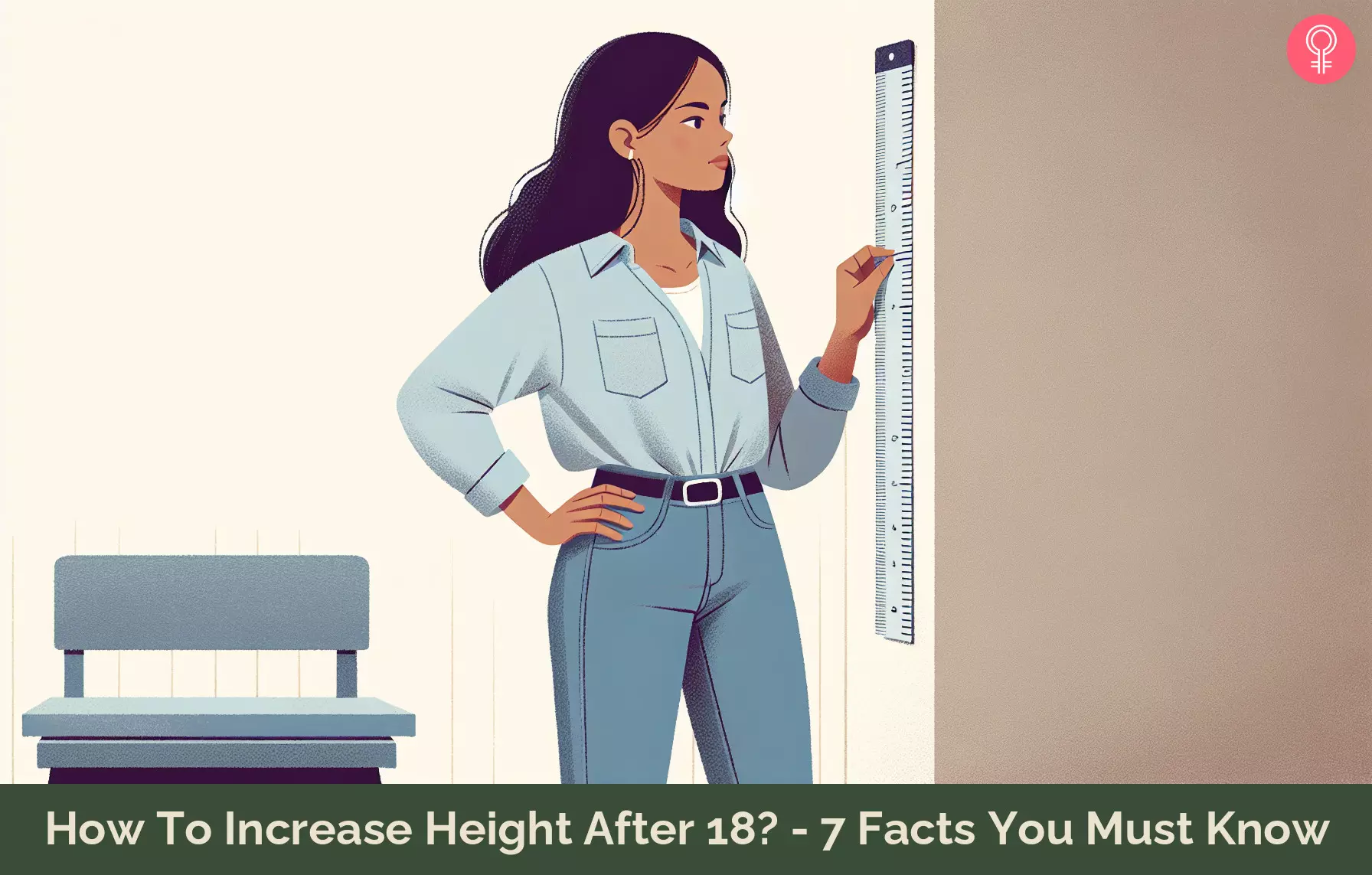
Image: Dall·E/StyleCraze Design Team
Can women increase their height even after turning 18? To find the answer to this question, check out the video below.
Personal Experience: Source
StyleCraze's articles are interwoven with authentic personal narratives that provide depth and resonance to our content. Below are the sources of the personal accounts referenced in this article.
i. How I grew taller In 21 days *shocking results*https://www.youtube.com/watch?v=y30n39Z-Zvw
References
Articles on StyleCraze are backed by verified information from peer-reviewed and academic research papers, reputed organizations, research institutions, and medical associations to ensure accuracy and relevance. Read our editorial policy to learn more.
- “The growth plate” The Orthopedic Clinics of North America, National Institutes of Health, USA.
- “The role of the growth plate in longitudinal bone growth.” Journal of the American Association of Instructors and Investigators in Poultry Husbandry, National Institutes of Health, USA.
- “2 to 20 years: Boys Stature Weight-for-age percentiles” CDC, USA.
- “2 to 20 years: Girls Stature Weight-for-age percentiles” CDC, USA.
- “Is height determined by genetics?”Genetics Home Reference, U.S. National Library of Medicine, USA.
- “Genetics of human height” Economics and Human Biology, National Institutes of Health, USA.
- “Advances in pubertal growth and factors influencing it: Can we increase pubertal growth?” Indian Journal of Endocrinology and Metabolism, National Institutes of Health, USA.
- “Relationship Between Timing of Peak Height Velocity and Pubertal Staging in Boys and Girls” Journal of Clinical Research in Pediatric Endocrinology, National Institutes of Health, USA.
- “Growth and Normal Puberty” Pediatrics, American Academy of Pediatrics.
- “Nutrition and Growth” Journal of Clinical Research in Pediatric Endocrinology, National Institutes of Health, USA.
- “Adult height, nutrition, and population health” Nutrition Reviews, National Institutes of Health, USA.
- “How does exercise affect bone development during growth?” Sports Medicine, National Institutes of Health, USA.
- “Effects of physical activity on children’s growth.” Jornal de pediatria, National Institutes of Health, USA.
- “Impact Exercise Increases BMC During Growth: An 8-Year Longitudinal Study” Journal of Bone and Mineral Research, National Institutes of Health, USA.
- “The effects of exercise on growth.” Sports Medicine, National Institutes of Health, USA.
- “Genetic and environmental influences on height from infancy to early adulthood: An individual-based pooled analysis of 45 twin cohorts” Scientific Reports, National Institutes of Health, USA.
- “Genetic and environmental influences on growth.” Journal of Medical Screening, National Institutes of Health, USA.
- “Environmental influences on human growth and development: historical review and case study of contemporary influences.” Annals of human biology, National Institutes of Health, USA.
- “Influence of environmental factors on height and weight of schoolchildren.” British Journal of Preventive & Social Medicine, National Institutes of Health, USA.
- “A century of trends in adult human height.” NCD Risk Factor Collaboration (NCD-RisC), eLIFE.
- “Calcium intake in bone health: a focus on calcium-rich mineral waters” MDPI, National Institutes of Health, USA.
- “Vitamin D and bone health; potential mechanisms” MDPI, National Institutes of Health, USA.
- “The basics of bone in health and disease” National Institutes of Health, USA.
- “Limb lengthening history, evolution, complications and current concepts.”Journal of Orthopaedics and Traumatology, National Institutes of Health, USA.
- “Physical stature decline and the health status of the elderly population in England.” U.S. National Library of Medicine.
- “Accuracy of patient-reported height loss and risk factors for height loss among postmenopausal women” U.S. National Library of Medicine.
- “Role of physical activity training in attenuation of height loss through aging.” U.S. National Library of Medicine.
- “Vitamin D and calcium in osteoporosis, and the role of bone turnover markers:A Narrative Review of Recent Data from RCTs.” U.S. National Library of Medicine.
Read full bio of Julie Erickson
Read full bio of Ravi Teja Tadimalla
Read full bio of Himanshi Mahajan
















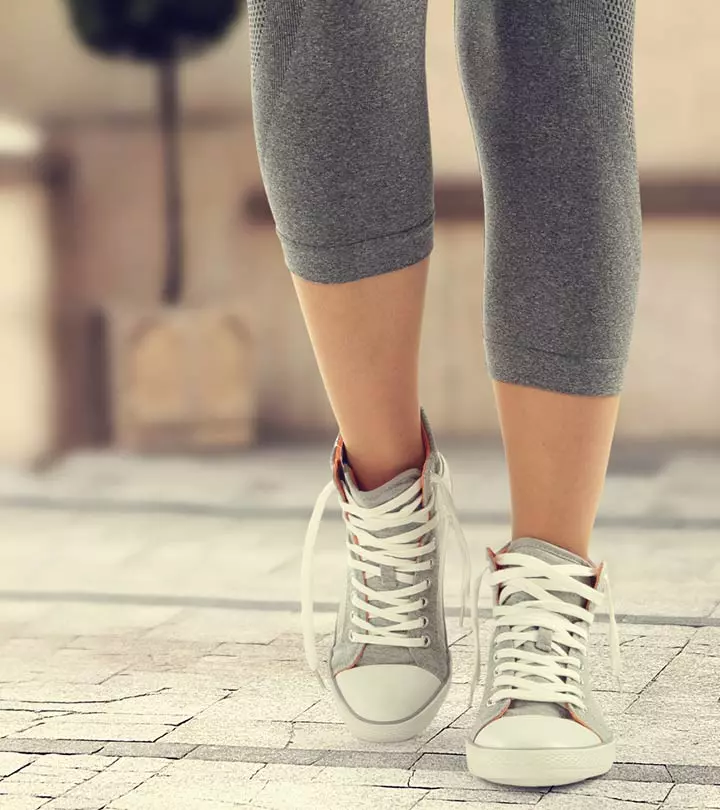
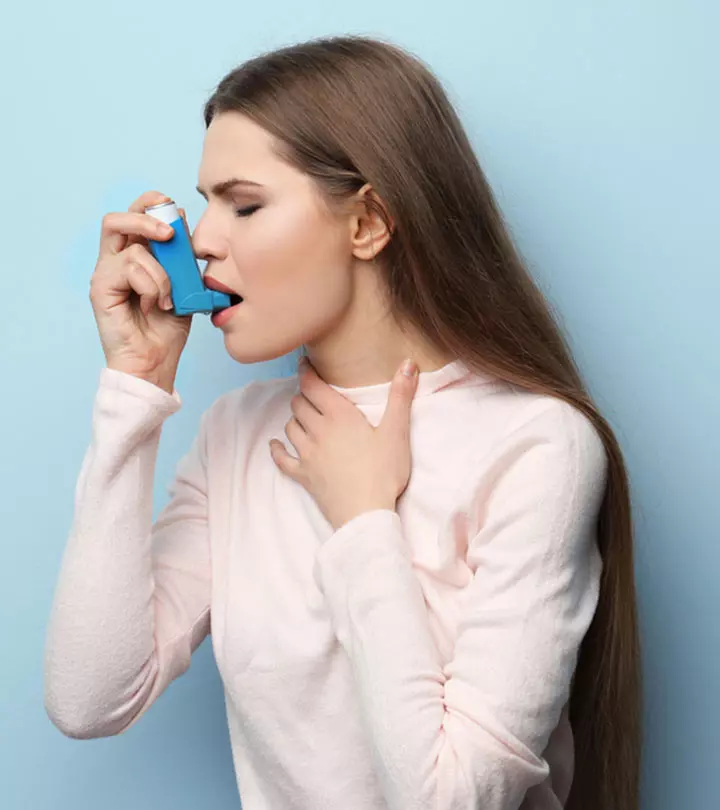




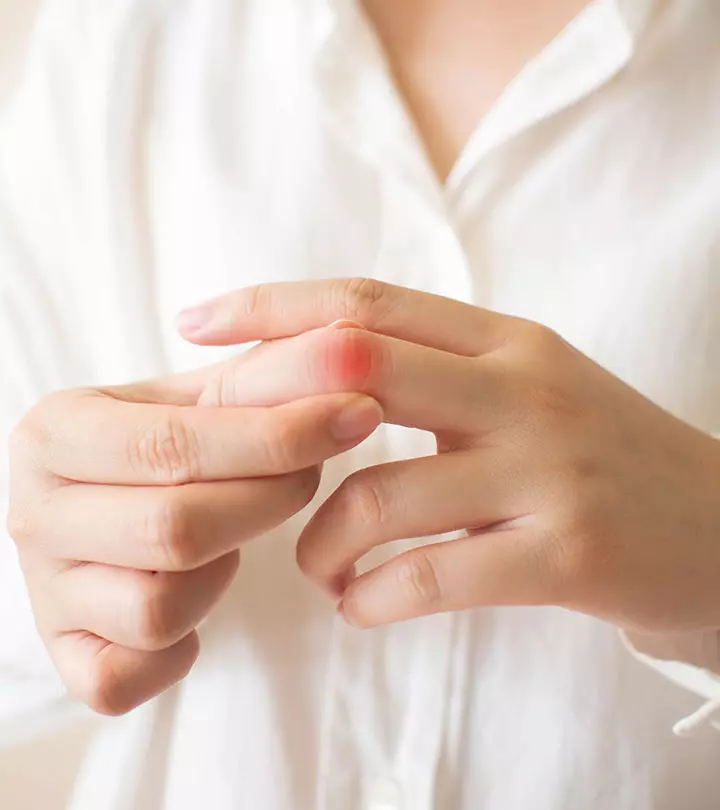

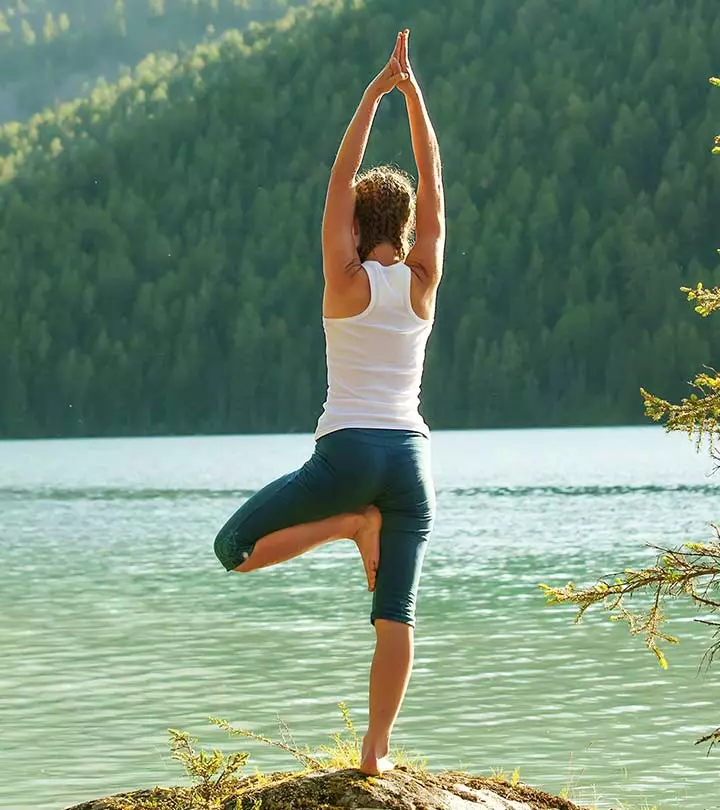

Community Experiences
Join the conversation and become a part of our empowering community! Share your stories, experiences, and insights to connect with other beauty, lifestyle, and health enthusiasts.